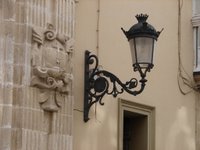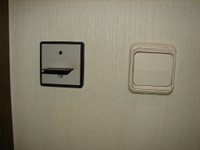 Goodbye to Spain
Goodbye to SpainSunday was our last full day in Spain. We got up late and checked out of the hotel and walked 5 minutes up the hill to the Pizzeria for breakfast. Lucca (Steffi's brother) greeted us along with our new friend Carlos. We sat down and ordered breakfast and waited to Luigi and Steffi to meet us. They had a busy Saturday night at the restaurant and Luigi intimated that he was short delivery people. Steffi had to ge
 t ready for lunch at the restaurant, so we said our sad goodbyes and made them promise to visit Rhode Island this fall. Luigi drove us to the airport and we were headed back to Barcelona.
t ready for lunch at the restaurant, so we said our sad goodbyes and made them promise to visit Rhode Island this fall. Luigi drove us to the airport and we were headed back to Barcelona.Of course our trip back to Barcelona could not be without incident. Since we had such good luck with the airport bus going to the airport, we decided to use it coming from the airport a s well. The problem was when we asked other passengers where to get off for our hotel they told us a stop a few miles from our hotel. With our backpacks loaded down with bottles of wine and olive oil for the trip back, I felt like I
s well. The problem was when we asked other passengers where to get off for our hotel they told us a stop a few miles from our hotel. With our backpacks loaded down with bottles of wine and olive oil for the trip back, I felt like I  was in the military loaded down with a month’s rations on my back.
was in the military loaded down with a month’s rations on my back.
Vespa held together with a trash bag
Since it was Sunday everywhere in the city was closed. No matter, we were tired and decided to lounge in the hotel bar. Glasses of
c ava (Spanish champagne), strawberries and cheese (including a VERY strong local goat cheese) made for a very elegant end to our trip.
ava (Spanish champagne), strawberries and cheese (including a VERY strong local goat cheese) made for a very elegant end to our trip.
Wild flowers in Puerto Sherry
What is elegance without a bit of annoyance? When we checked into our room, we couldn’t get the lights to work. I tried every switch I could find. I tried every combination of turning switches on and off to n o avail. These lights were not going on. Karen was finally so annoyed that she called the front desk. That is when I saw the slot. Giving it a try, I put the key card in the slot and hit the switch. Let there be light!
o avail. These lights were not going on. Karen was finally so annoyed that she called the front desk. That is when I saw the slot. Giving it a try, I put the key card in the slot and hit the switch. Let there be light!
The infamous light switch code is broken






